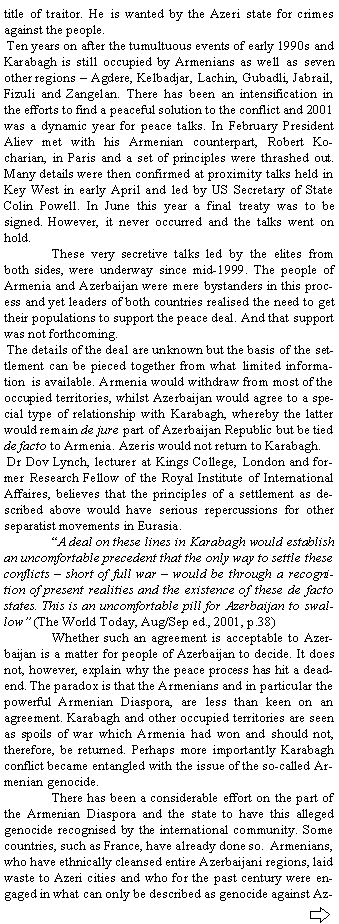|
I remember walking along the city-walls of the great Azerbaijani city of Shusha, gazing up at its ancient citadels. It was the Summer of 1985 and I was five years old. That was to be my last visit to Karabagh, the land of my ancestors, for within three years Armenian expansionism turned that beautiful country into a living hell.
As I played in the shadow of the towers of the Shusha Fortress I did not know that this was the place where ancient Azeris fought off Mongol and Arab invasions and it was here that Karabaghi khans launched their resistance to Armenian incursions in the Middle Ages. It was Shusha where Panah Khan and his son Ibrahim fought away the Qajar and Russian armies in the 19th Century. This is the place which defined Azerbaijani history and shaped its course. Over the last two centuries Azerbaijani population of Karabagh decreased - removed under tsarist-Russian policy of settling Armenians into South Caucasus following the Turkmenchai Treaty of 1828; killed off in genocidal massacres perpetrated by Armenians between 1914 and 1920 and again sent elsewhere during the Soviet-era resettlement programmes in 1920s and 30s. Yet through all that Shusha stood firm - the bastion of Azerbaijan, the cradle of our literature, music and possibly our whole cultural identity; home of some of our greatest composers, poets and writers such as Bul Bul, Uzeir Hajibeyov, Natavan and Vaqif. Shusha represents everything that Karabagh (translated from Azeri as black garden) means to Azeri people and Azerbaijan as a state.
Today there is not a single Azerbaijani left in Karabagh. After centuries of persecution and physical destruction of Azeris in Karabagh, the last of its forty thousand inhabitants fled the region in the early 1990s. They live in dreadful conditions together with some 700,000 people from other regions of Azerbaijan occupied by Armenian Republic and nearly 300,000 Azeris who were expelled from Armenia itself right at the beginning of the conflict in 1988-89. In Armenia Azerbaijanis lived compactly in Zangezur, historical Azeri land given to Armenia by Soviet authorities in 1923.
A whole swath of South Caucasus - from Kelbadjar and Agdere in the North to Jebrail and Fizuli in the South - has been ethnically cleansed of Azerbaijanis as part of a wider plan to build a "Greater Armenia". Terror was used to force people off their lands, which they inhabited since time immemorial. Kodjali Massacre stands out as a single, most potent symbol of the tragedy that had befallen Azerbaijan. Armenian army with support of Russian troops, captured the town in February 1992 and massacred over eight hundred people in what Helsinki Human Rights Watch described as "the worst atrocity of the (Karabagh) conflict".
The strategy was to terrorise Azerbaijani population into fleeing Karabagh and it was ultimately successful. After Kodjali people did not wait to be massacred en masse and left their towns and villages as Armenian forces approached. Much of the blame for failure to protect Azeri people in Karabagh lies with the then government of Ayaz Mutalibov (a Communist chief), whose dog-like allegiance to Russia has been a subject of much discussion and "earned" him a
|
|


